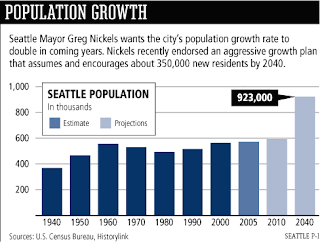Let’s get into the geography and topography of it all:
Seattle belongs to the Pacific mountains and valleys physiographic region.
Seattle residents enjoy the amenities of their mountain scenery, but many Cascade peaks, such as Washington’s Mt. Rainier, are active volcanoes that threaten nearby metropolitan areas.
Seattle is surrounded by water because it sits on an isthmus between Puget Sound and Lake Washington.
The Seattle area was formed hundreds of thousands of years ago during different ice ages - most dramatically during the Pleistocene age.
Large glaciers moved down from the north, blanketing the area under more than a thousand feet of ice. This sheet of ice was so deep it would have buried all of the current skyscrapers with plenty of room to spare. The glacial lobe reached as far south as what is now the city of Olympia.
The weight of these slow moving ice fields actually depressed and scraped out the earth below. The result was the creation of valleys, troughs, basins and ridgelines of hills all oriented in a generally north/south direction.
As the climate warmed and the glaciers retreated for the last ice age, the ocean that got clogged thundered into the empty space in a series of gigantic floods. The deepest depressions became Puget Sound, which is 200-300 feet deep in some areas. Other areas were slowly filled with fresh water. These places became Lake Washington and Lake Sammamish, which can be 100-200 feet deep in some areas.
Today, the soils in the city are called "glacial till" because they are soft, sandy and rocky; the remnants of all that earth moving. Large amounts of rain filter through the rocky soil, sometimes returning to the surface as seasonal springs. The glaciers are still here too. FUN FACT: Washington State is home to more glaciers than any other state except Alaska.
Mt. Rainier alone accounts for a huge percentage of the nation's glacial ice. Glaciers are also present on Mt. Adams, Glacier Peak, and Mt. Baker, all of which happen to be volcanoes. Thus, Washington is often referred to as the land of "fire and ice." Sadly, these glaciers are all shrinking and receding due to the current global warming trend.
So does the Pacific Northwest have earthquakes? Yup, it does…
Seattle is located at a convergent continental boundary, where two tectonic plates are colliding. This boundary is called the Cascadia Subduction Zone. It lies offshore and runs from British Columbia to northern California. The two plates are converging at a rate of about M 3-4 cm/year (1-2 inches/year), and the northeast-moving Juan de Fuca Plate is pushing into North America, causing stress to accumulate. Earthquakes are caused by the abrupt release of this slowly accumulated stress.
One of the largest earthquakes in Washington is thought to be the 1872 earthquake that had a magnitude of 7.0; it hit near Lake Chelan, Washington. This earthquake was felt from British Columbia, Canada, to Oregon and from the Pacific Ocean to Montana.
More recently, three other significant earthquakes have occurred in Washington. A magnitude 5.3 earthquake hit Seattle on May 2, 1996. Another earthquake struck Western Washington on July 2, 1999 and the most recent major earthquake, the Nisqually quake, was a magnitude 6.8 and struck near Olympia, WA on February 28, 2001. Mostly cloudy with a chance of rain… climatic factors in and around the Seattle area…
The keys to understanding climatic patterns in the East are temperature and latitude, whereas in the West, the keys are precipitation and topography. Seattle is located at the most northern latitude of any major city in the continental U.S.; it is 47.6 degrees of latitude. As a result, summer days are long with 16 hours of daylight on June 21. On the other hand, winter days are dark, gloomy, and short with only 8.5 hours of daylight on December 21. Since Seattle is close to a body of water, its temperature doesn’t experience great seasonal extremes.
Seattle is part of the humid mesothermal climatic region; it is classified Cfb, which means that it is a humid, subtropical area with the warmest month mean temperature under 71.6°F (22°C) and where at least 4 months have means over 50°F (10°C). Seattle also belongs to the subtropical evergreen forest vegetation region. The Seattle area has highland soils which means that throughout the high and rugged terrain there is little development, and it is agriculturally worthless. Maybe that’s why fishing is a better deal for the Seattleites. Similar to New York, Seattle has very high quality tap water. The water can be traced all the way to the rain and snowpack of the Cascades, where water feeds into two protected watersheds located in the foothills near the city. Watersheds, or drainage basins, are areas of land where all the water from it drains to the same place. The Cedar River watershed (the water source that feeds Lake Washington and, by extension, Puget Sound) provides 70 percent of Seattle’s drinking water.























